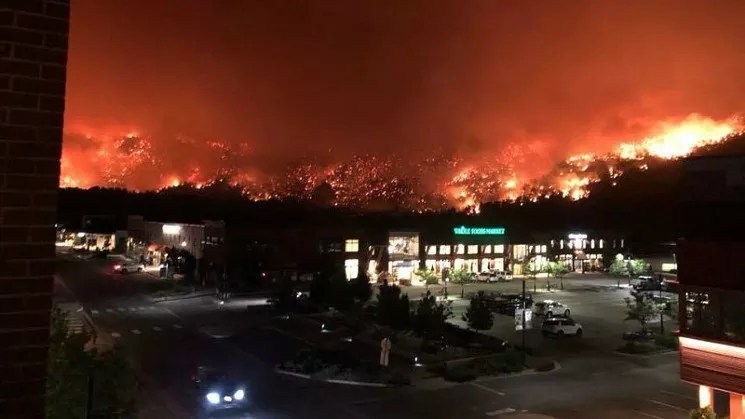
Photo by Katie Baum Hueth courtesy of the Eagle County Sheriff’s Office

Audio By Carbonatix
In recent months, Colorado and a slew of other states have been hit with a historic number of enormously destructive wildfires. According to Michael Kodas, the Colorado-based author of the prescient and authoritative book Megafire: The Race to Extinguish a Deadly Epidemic of Flame, the drivers of the crisis fall into four overarching categories, with the first of them being symbolized by an iconic figure that’s been portrayed as heroic for generations.
“In my presentations, I talk about Smokey Bear being possibly the most controversial character in American wildland firefighting,” notes Kodas, who also serves as the associate director of the Center for Environmental Journalism at the University of Colorado Boulder.
Why? Kodas explains that and a lot more in the following wide-ranging conversation, which pinpoints many of the reasons wildfires have been growing ever more destructive and the failure of folks in a position of power to effectively address the situation.
The Genesis of Megafire
“I cover a lot of ground in the book. I start with the Four Mile Canyon fire outside Boulder, which broke out on Labor Day in 2010. It happened to be breaking out the day I was moving into a cabin in a park near where the fire ignited.
“Over the next four years, Colorado broke its most-destructive-fire record four times. I took what I learned about the fires in Colorado and traveled around the country and, to some degree, the globe to look at how the issues I identified in Colorado were playing into the increase of the size and destructiveness and death tolls from wildfires around the world.”
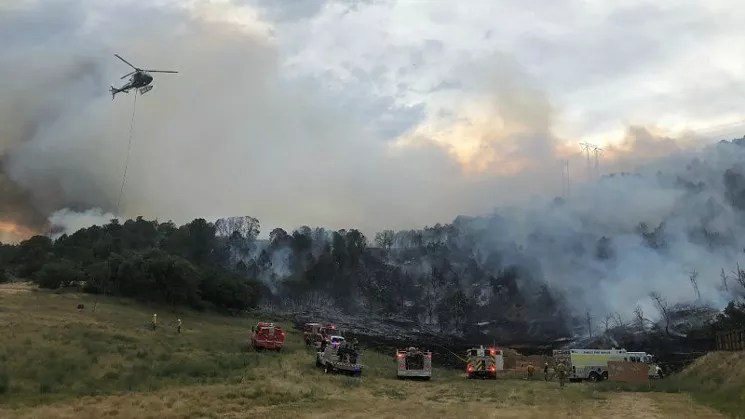
A helicopter deployed to fight the Lake Christine fire in July.
Eagle County Sheriff’s Office
The Outdated Definition of Megafires
“The U.S. Forest Service defines any fire that’s larger than 100,000 acres as a megafire. But I came to the conclusion that it’s not a very good metric. There are wilderness areas and remote forests where big fires like that have always burned and are necessary for that ecosystem to be healthy. But there are a lot of smaller fires that have huge impacts; they kill people, destroy homes, put the watershed at risk and threaten infrastructure like dams and power lines. That’s why I feel impacts are a much better measure of fires than than their size.
“Even small fires that burn in a way that’s not consistent with the way fires in that landscape have burned historically can be very negative. They can damage the soil and have greater impacts on people and the planet than a really big fire that’s burned in places big fires have always burned and that we should expect there.”
Problem One: Forest Management (and Smokey’s Role In It)
“Smokey Bear is one of the most successful advertising campaigns in history. By some measures, he’s better known than Mickey Mouse. But he represents a zero-tolerance policy for wildfires, and the results have led us to where we are today.
“I write a lot about the Big Burn of 1910 in Idaho and Montana, which helped determine wildlife policy for the next 100 years. For 75 or 80 years afterward, we fought every fire, and the result was that forests became horribly overgrown.

The cover of Megafire.
“Look at lodgepole pine forests that grow at an elevation of 8,000 feet or higher. In those forests, we’ve seen whole mountainsides burn, because the trees need fire to reproduce. The seeds are held in serotinous cones. They’re basically sealed with a wax that releases the seeds in fire. That’s what’s always happened, and our full-suppression century, the twentieth century, didn’t have a lot of effect on those forests, because the fires there burn very infrequently – every 200 or 300 years.
“It’s a different story in ponderosa pine forests, particularly the lower-elevation forests, where we most like to build our mountain homes in Colorado. They evolved with frequent, low-intensity fires, because the trees don’t like to be in a very dense stand. They like to be in little clumps of two or three or four trees with big meadows between them. Those frequent, low-intensity fires killed off all their little competitors – the trees and scrubs and grasses. And big daddy ponderosa pines have evolved with this very thick bark and other adaptations that allow them to tolerate those low-intensity fires, which tend to burn every seven to ten years, as opposed to 200 or 300 years.
“But if you put out every fire for a century in a forest that’s used to burning every seven years, you’re going to have an exponential increase in fuel. In some forests in Arizona, I found forty times more trees in them than they had historically, and in Colorado, it’s not uncommon to see ten to twenty times more trees than they’ve had historically. That’s changed the whole structure of the forests. They’re not clumpy trees spread out, but a lot of trees closer together. The forest is also darker and cooler than it once was. That lets vegetation move in, and oftentimes it’s very flammable. If a fire gets into that, it’s going to burn very differently than it has historically.
“So Smokey Bear’s message has had a profound impact on some of our forests, but not all of them. It just happens that the forests that were most susceptible to getting overgrown were the ones we were most likely to build and recreate in. Look at Colorado Springs and Boulder, where we build a lot. Most people don’t recognize that the forests they’re building in are unhealthy by some foresters’ measures, and sometimes we make things worse by planting things in those forests, including planted timber.”
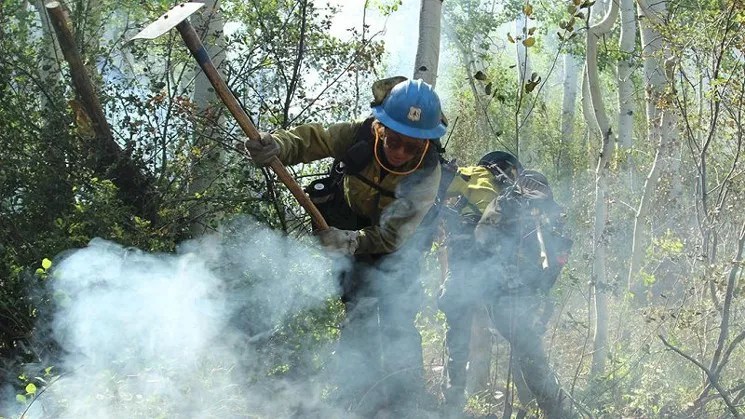
Fighting the Lake Christine fire at ground level in July.
inciweb.nwcg.gov file photo
Problem Two: Development
“This is a controversial one. A few years ago, the U.S. Forest Service did a study estimating that more than a third of homes are in the wildland urban interface. That means a third of the homes in the nation are in a place where they could burn in a wildfire.
“Now, when we build and develop an area, we do a couple of different things that influence wildfire. First, people who live there expect fires to be put out, which puts us back in the suppression mode. The second thing is, we’re introducing a whole new type of food for fires: houses, vehicles with fuel in them, lawnmowers, all kinds of things that can burn and change the nature of how a fire will behave. And the final thing, and increasingly the most important thing, is that we have become the primary fire starter.
“At CU, Jennifer Balch’s Earth Lab has done some amazing research. They put out a study about a year and a half ago that basically parsed every fire report from every agency in the U.S. over a twenty-year period, and they determined that across the country, 84 percent of wildfires were started by humans – and in places like California, it’s closer to 95 percent.
“When we hear that kind of figure, we think of an arsonist or someone with a cigarette. But those kinds of things are in the minority. Power lines start a huge number of wildfires. So do sparks off car rims – that’s what started the Carr fire in California. There’s also target practice, which started the Lake Christine fire near Basalt. We become the primary fire starters in the forests near developed area, and that changes the nature of the fire season.
“There are a couple of ways to look at our fire seasons. One is when fires would ignite naturally – and the only natural ignition of note is lightning. But we start wildfires 365 days a year even though lightning season is only a couple of months. If you see a wildfire start when there aren’t any thunderstorms, that gives you an idea that humans probably caused it.”
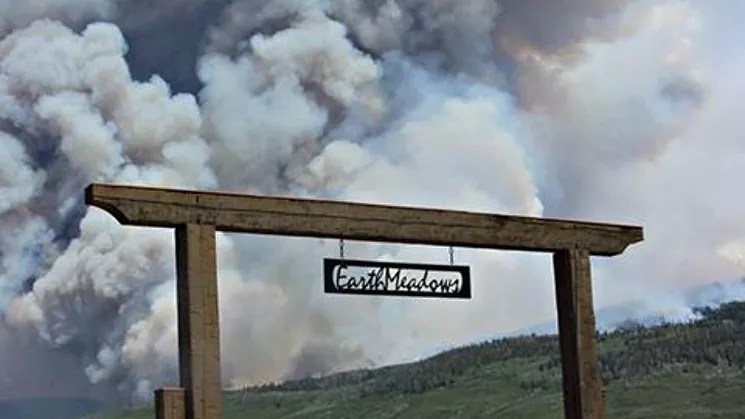
A July photo of a smoke cloud from the Lake Christine fire over a Basalt ranch.
inciweb.nwcg.gov file photo
Problem Three: Climate
“We’ve seen the period when forests are dry enough to burn expand by more than two months in the last several decades – and that’s only one of the ways climate has impacted wildfires. We’ve had really hot, really dry weather like we’ve never seen in many areas of the West, and that’s going to lead to fire behaviors that are unusual – like a fire that burns intensely during the night rather than laying down when the temperatures drop and humidity rises, or a fire that burns quickly downhill rather than uphill.
“A warmer, drier climate also affects the snowpack. If you look at a snowcapped peak in Colorado with a forest beneath it, that snowcapped mountain is effectively a little trickle reservoir that keeps the forest below it moist and less likely to burn. But if you get less snow than usual, as we did last year and as we’re increasingly seeing, or if the snow comes earlier or later than usual and melts off sooner, then that forest is available to burn earlier and later in the season. Those are the kinds of things that have allowed the actual wildfire season in most of the West to expand by months. The last figure I saw was 78 days.
“Having wildfires year-round creates a lot of challenges. I worked for one summer as a Forest Service firefighter many years ago, and during that period, a lot of the personnel consisted of college students. But college students aren’t available to fight wildfires in March or October. They’re in school then. And a lot of the equipment we rely on to fight wildfires, the bulldozers and so on, have to be warehoused, and it becomes a really expensive burden to make those resources available during the kind of shoulder seasons we’re seeing. Wildfires that aren’t very frequent can still be very serious. We’ve had fatal wildfires in what’s basically winter or the first days of spring, when we wouldn’t normally see them. So the climate impacts are really undeniable.”
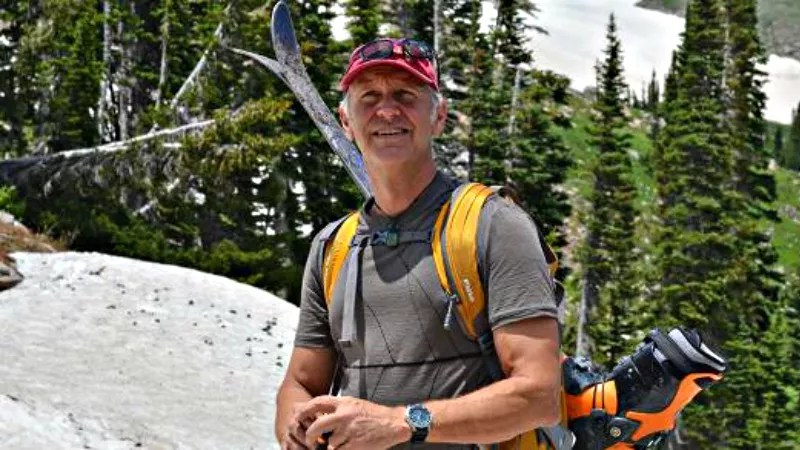
Michael Kodas out in the kind of nature he wants to thrive.
Problem Four: The Intersection of Economics and Politics
“The decisions about how to deal with wildfires are being made for political or economic purposes rather than safety and ecological purposes, and that can lead to all kinds of different issues over the long run. It’s not just climate-change denial, which prevents us from being able to make decisions that might lead to a slightly cooler or moister climate in the future. There are also more immediate ways this comes into play.
“For example, during the past couple of bad wildfire seasons, our presidential administration and the Secretary of the Interior have tweeted or announced that we haven’t allowed enough logging in our forests, and that’s part of why this is happening. But what we really need removed from forests are scrappy little trees and scrub and grass and a lot of the finer fuels and scruffy vegetation that’s crowding the forest, not the big, granddaddy trees that have proven that they can survive wildfires and actually makes forests more resilient. However, a logging company only wants the big trees. They’re what’s more valuable. There’s almost no economic value in the finer fuels we really need to pull out of the forests.
“You’ll also hear arguments that we should have more grazing – that grazing can knock down more of these finer fuels if it’s well managed and not overgrazed. But overgrazing has contributed to the problem by removing grasses that have allowed forests to get overgrown.
“Another thing we’re told we should do is invest more in the fire industrial complex: more planes, more resources to fight fires. But while that’s economically advantageous to the industry, the cost of wildland fires to our nation is enormous. I write a lot about this in the book. In the early 1990s, the nation spent somewhere around $300 million a year dealing with preparing for fighting and recovering from wildfires. Last year, in a bad fire year, and this is certainly another one, we spent $3 billion.

Smoke from the Lake Christine fire seen from a distance.
pitkinalert.org file photo
“To give you another measure: In 1995, the Forest Service spent 16 percent of its budget dealing with wildfires. Last year, it was 56 percent – and more than half of that money goes to the private sector. When you go to a fire camp, you’ll see a mobile commissary to feed the firefighters, mobile shower units so the firefighters can wash up every day or two, a mobile laundry where you can clean your clothes. All of these services are provided by private companies – and that’s before you get to things like aircraft. The majority of helicopters and planes are from private companies, and bulldozers, too.
“Like with any business, these industries want as much work as they can get, so they’ll want to fight every fire, even if it’s a fire we probably shouldn’t fight – one that will thin out some excess vegetation that could make the next fire worse. So the amount of money we’re spending isn’t just a financial burden for federal, state and municipal governments. It’s also an incentive to spend even more money in the future. And all of those things play into the politics and economics of wildfires.”
Is There Any Escape From the Worst-Case Scenario?
“Political will can change. Increasingly, fire scientists and land managers are thinking less about ‘We’re going to fight every wildfire’ and more about ‘How do we live with wildfire?’ Rather than spending a ton of money to protect homes in flammable landscapes, how can we make those homes less vulnerable to fires that are going to burn there one way or another?
“But the underlying physical drivers to wildfires aren’t going to change. Several years ago, there was a conference in Denver where scientists released a paper estimating that by mid-century, we’re going to see twice as much fire on federal land as we do today. Now, in 2015, we had 10 million acres burn. If that number is 20 million acres in 2050, that’s an area the size of the state of Maine. We need to be prepared for that. We can do it in incredibly painful ways – with huge increases in homes burned and lives lost. Or we can accept that fires are going to happen no matter what and be smarter about how we deal with them.”